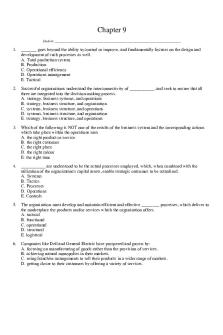Chem I Chapter 9 Review + Chapter 5 PDF

| Title | Chem I Chapter 9 Review + Chapter 5 |
|---|---|
| Author | Sophia Kirn |
| Course | Introd Chemistry I |
| Institution | Appalachian State University |
| Pages | 2 |
| File Size | 32.8 KB |
| File Type | |
| Total Downloads | 87 |
| Total Views | 171 |
Summary
Lecture notes on bonding and thermochemistry with problems and equations from Dr. Ariyadasa's course...
Description
Sigma bonds: ● Head to head overlap ● Cylindrical symmetry of electron density about the internuclear axis ● Stronger than pi bonds Pi bonds: ● Sideways overlap ● Electron density above and below the internuclear axis Double bond: ● 1 pi bond and 1 sigma bond Triple bond: ● 1 sigma bond and 2 pi bonds Example problem: There are ________ sigma bonds and ________ pi bonds in CH2CHCH3 Answer: 8,1 Localized or delocalized electrons: ● Bonding electrons (sigma or pi) that are specifically shared between two atoms are called localized electrons ● In many molecules, we cant describe all electrons that way (resonance). These are called delocalized electrons Resonance structures: ● No single, double, or triple bonds; just an average of the bonds Thermochemistry: ● Study of energies given off by or absorbed by reactions ● Energy - The ability to do work or transfer heat ○ Potential energy - stored energy ○ Kinetic energy - the energy of motion The first law of thermodynamics: ● Energy can be converted from one form to another, but it cannot be created or destroyed Types of systems: ● Open- can exchange heat, energy, and mass with its surroundings ● Closed- can only exchange heat with its surroundings, not mass ● Isolated- cannot exchange heat or mass with its surroundings Internal energy: ● The sum of all kinetic and potential energies of all components of the system ● E is not generally known, only how it changes (delta E) ● The change in internal energy is the final energy of the system minus the initial energy of the system ● If delta E is greater than 0, then the system absorbed energy ● If delta E is less than 0, then the system released energy Thermodynamic quantities have 3 parts: 1. A number 2. A unit
3. A sign a. A positive delta E results when the system gains energy from the surroundings b. A negative delta E results when the system loses energy to the surroundings...
Similar Free PDFs

Chapter 9 Review Questions
- 11 Pages

Psychology Chapter 9 review
- 5 Pages

Chapter 9 review quiz
- 120 Pages

Chapter 9 exam review
- 41 Pages

Chapter 9 Review Questions
- 5 Pages

Chapter 9 Review Housekeeping
- 2 Pages

Chapter 5 Review Questions
- 5 Pages

Chapter 5 review answers
- 5 Pages

Chapter 5 Review Questions
- 4 Pages

Chapter 5 review questions
- 2 Pages

Chapter 5 Review Questions
- 3 Pages

Chapter 5 Exam Review
- 5 Pages

Chapter 5 review worksheet
- 4 Pages

Knowledge Review Chapter 5
- 2 Pages

Chapter 5 Review Questions
- 11 Pages
Popular Institutions
- Tinajero National High School - Annex
- Politeknik Caltex Riau
- Yokohama City University
- SGT University
- University of Al-Qadisiyah
- Divine Word College of Vigan
- Techniek College Rotterdam
- Universidade de Santiago
- Universiti Teknologi MARA Cawangan Johor Kampus Pasir Gudang
- Poltekkes Kemenkes Yogyakarta
- Baguio City National High School
- Colegio san marcos
- preparatoria uno
- Centro de Bachillerato Tecnológico Industrial y de Servicios No. 107
- Dalian Maritime University
- Quang Trung Secondary School
- Colegio Tecnológico en Informática
- Corporación Regional de Educación Superior
- Grupo CEDVA
- Dar Al Uloom University
- Centro de Estudios Preuniversitarios de la Universidad Nacional de Ingeniería
- 上智大学
- Aakash International School, Nuna Majara
- San Felipe Neri Catholic School
- Kang Chiao International School - New Taipei City
- Misamis Occidental National High School
- Institución Educativa Escuela Normal Juan Ladrilleros
- Kolehiyo ng Pantukan
- Batanes State College
- Instituto Continental
- Sekolah Menengah Kejuruan Kesehatan Kaltara (Tarakan)
- Colegio de La Inmaculada Concepcion - Cebu
